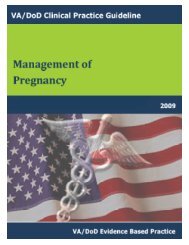DM Full Guideline (2010) - VA/DoD Clinical Practice Guidelines Home
DM Full Guideline (2010) - VA/DoD Clinical Practice Guidelines Home
DM Full Guideline (2010) - VA/DoD Clinical Practice Guidelines Home
You also want an ePaper? Increase the reach of your titles
YUMPU automatically turns print PDFs into web optimized ePapers that Google loves.
Version 4.0<br />
<strong>VA</strong>/<strong>DoD</strong> <strong>Clinical</strong> <strong>Practice</strong> <strong>Guideline</strong><br />
for the Management of Diabetes Mellitus<br />
J-4. CONTINUOUS SUBCUTANEOUS INSULIN INFUSION (CSII)<br />
BACKGROUND<br />
Continuous subcutaneous insulin infusion (CSII) was introduced in the 1970s as a way of achieving glycemic<br />
control in patients with type 1 diabetes. With the recognition of the benefits of tight glycemic control, insulin<br />
regimens mimicking physiologic insulin secretion have become more commonly used in patients not meeting<br />
glycemic goals with less intensive insulin regimens. This can be achieved through use of insulin regimens that use a<br />
basal-bolus approach with multiple daily injections (MDI) and with CSII. More recently, the same approach has<br />
been used to varying degrees in patients with type 2 diabetes. As both approaches are effective at achieving tight<br />
glycemic control and are in widespread use, recent literature has concentrated on comparison of MDI and CSII with<br />
respect to efficacy and safety.<br />
RECOMMENDATIONS<br />
1. CSII therapy should only be initiated and managed by an endocrinologist/diabetes team with expertise in<br />
insulin pump therapy<br />
2. CSII therapy should only be considered in patients who have either documented type 1 diabetes [history of<br />
DKA, low c-peptide or evidence of pancreatic autoimmunity] or be insulin deficient with a need for<br />
intensive insulin therapy to maintain glycemic control and are not able to maintain it using multiple daily<br />
injections (MDI) therapy. This may include patients with:<br />
a. Poor glycemic control (including wide glucose excursions with hyperglycemia and serious<br />
hypoglycemia and those not meeting HbA 1 c goal) despite an optimized regimen using MDI in<br />
conjunction with lifestyle modification. [A]<br />
b. Marked dawn phenomenon (fasting AM hyperglycemia) not controlled using NPH at bedtime,<br />
glargine or detemir. [B]<br />
c. Recurrent nocturnal hypoglycemia despite optimized regimen using glargine or detemir. [B]<br />
d. Circumstances of employment or physical activity, for example shift work, in which MDI<br />
regimens have been unable to maintain glycemic control. [I]<br />
3. Patients using CSII should have:<br />
a. Demonstrated willingness and ability to play an active role in diabetes self-management to<br />
include frequent self-monitoring of blood glucose (SMBG), and to have frequent contact with<br />
their healthcare team.<br />
b. Completed a comprehensive diabetes education program.<br />
4. The use of CSII over MDI regimens is not recommended in most patients with type 2 diabetes. [D]<br />
DISCUSSION<br />
The use of long- and rapid-acting insulin analogs for MDI appears to be superior to older regimens using NPH for<br />
basal insulin and Regular for bolus insulin. CSII safety and efficacy has also improved over the past decade owing<br />
to significant technologic advances in insulin pumps and the shift from use of Regular insulin to rapid-acting<br />
analogs. As greater experience was gained with use of CSII, the incidence of hypoglycemia declined significantly,<br />
and in fact some earlier studies (e.g., Bode, 1996) indicated that CSII was associated with a significant decrease in<br />
severe hypoglycemia in patients switched from MDI therapy. Modern insulin pumps offer the ability to set varying<br />
basal rates throughout the day, improving the ability to overcome the dawn phenomenon and to decrease nocturnal<br />
hypoglycemia. These advances over the past decade bring into question the relevance to older literature comparing<br />
CSII and MDI.<br />
In patients with type 1 diabetes, CSII has been shown in randomized controlled trials to result in improved glycemic<br />
control as measured by HbA1c or fructosamine compared to MDI. (Hirsch et al., 2005, Hoogma et al., 2006) While<br />
the difference in HbA1c between groups was statistically significant in these two randomized controlled trials as<br />
well as three meta-analyses looking at adult patients (Fatourechi et al., 2009; Jeitler et al., 2008; Retnakaran et al.,<br />
2004), the absolute difference in HbA1c was in the range of 0.2 – 0.4%. The clinical significance of this degree of a<br />
reduction in HbA1c is uncertain.<br />
Module G: Glycemic Control Page 64
















